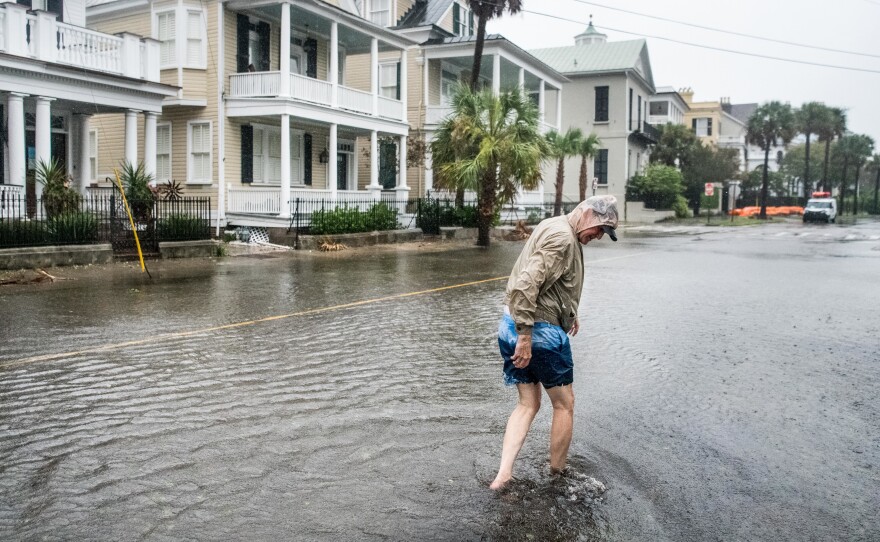Hurricane Dorian is churning just off the coast of the Carolinas, flooding areas along the shore of both states with a storm surge that could measure up to 5-8 feet. The storm, which regained Category 3 intensity overnight, now threatens heavy rainfall up to 15 inches and flash flooding. It has also spun off apparent tornadoes.
As of 3 p.m. ET, Dorian's maximum sustained winds were at 110 mph — the upper limit for a Category 2 storm.
"We urge everybody to stay inside. If you don't need to be out, don't go out. And in this kind of situation, you don't need to go out," South Carolina Gov. Henry McMaster said at a news conference Thursday afternoon, adding that the state would be lifting evacuation orders for three counties.
But McMaster added that the situation remains very much in flux, telling residents, "Stay off the streets. It's very dangerous."
For the time being, Dorian's eyewall continues to whip the waters some 60 miles south of Myrtle Beach, S.C., following a path toward the north-northeast.
"The center of Dorian will continue to move close to the coast ofSouth Carolina this afternoon, and then move near or over the coastof North Carolina tonight and Friday," the NHC predicts in its 2 p.m. ET advisory. "The center should move to the southeast of extreme southeastern New England Friday night and Saturday morning, and approach Nova Scotia later on Saturday."
Though the storm's eye remains offshore, it continues to thrash the Carolinas with its outer rain bands. Landfall remains possible Thursday — and if Dorian strengthens a bit and its eye reaches the coast, it could be just the fifth hurricane of Category 3 or higher to hit South or North Carolina since 1950, according to Colorado State University meteorologist Philip Klotzbach.
Even if Dorian does not come ashore, its proximity and steady strength promise a dangerous day for residents in the Southeast, where more than 1 million people are under mandatory evacuation orders.
"It is serious, and it can be deadly," North Carolina Gov. Roy Cooper told a news conference Thursday morning. "The message this morning is this: Get to safety and stay there. Don't let your guard down. This won't be a brush-by. Whether it comes ashore or not, the eye of the storm will be close enough to cause extensive damage in North Carolina."
Cooper's constituents need not look far to find what Dorian has been capable of. In the Bahamas, which Dorian battered for more than two days, authorities say at least 20 people have died, and they fear that death toll could rise significantly as rescue and recovery efforts unfold on the Caribbean island chain.
Images from the area reveal houses leveled, docks washed away and entire neighborhoods reduced to landscapes of rubble and ruin.
"We don't have a full scope of the damage," Vice Adm. Scott Buschman, who oversees U.S. Coast Guard operations in the Atlantic, tells NPR's Morning Edition. "But the areas I flew over yesterday — and I haven't flown over a lot of storms — I saw, if not the most significant damage and destruction, probably the most significant damage and destruction I've ever seen."
Now, South Carolina and North Carolina are facing a slightly diminished— but still dangerous — Dorian. According to the National Hurricane Center, the storm is creating conditions that can also spawn tornadoes in the storm-lashed regions. Videos recorded Thursday morning in North Myrtle Beach, S.C., and Pender County, N.C., appear to show tornadoes taking shape amid the whipping winds.
In Charleston, persistent rain sheets from Dorian pelted the city and severe winds toppled tree limbs and rattled buildings.
A recent drive around the city revealed street after street had been made impassible by flooding or debris pile-ups. Emergency responders helped cars stuck in the pooled water reach safety after motorists underestimated the depth of flooding. Other drivers got out of their cars and measured the inundation with tree sticks to gauge whether waters were safe to pass through.
Above the mostly vacant streets, menacing clouds lingered as out-of-order traffic signals swayed back and forth in Dorian's howling gusts. Hotels in Charleston were operating on power generators, with lights in some rooms flickering every couple of minutes.
And that's unlikely to be the end of it. Forecasters say afternoon high tides in Charleston could worsen flooding before the storm treks toward North Carolina's Outer Banks.
Meanwhile in Georgia, residents of Tybee Island, a barrier island beach town of some 3,000 people, breathed a collective sigh of relief after Dorian's coastal impact fell far below initial estimates in their area.
Resident Megan Hall, who was among those defying mandatory evacuation orders, spent Wednesday night at a beachfront bar and then went home and made dinner. There was really nothing unusual about the evening, she said, despite a hurricane with more than 100 mile per hour winds churning just off the coast.
"Our biggest fear was flooding," Hall said, "and we didn't have any of it."
Dorian is now sprawling far to the north. In Canada's provinces of Newfoundland and Labrador, authorities are hoping for a similarly sunny outcome — but they're not taking a risk. They have already warned of the possibility of tropical storm-force winds and "rough and pounding surf" related to the hurricane.
Copyright 2019 NPR. To see more, visit https://www.npr.org.






